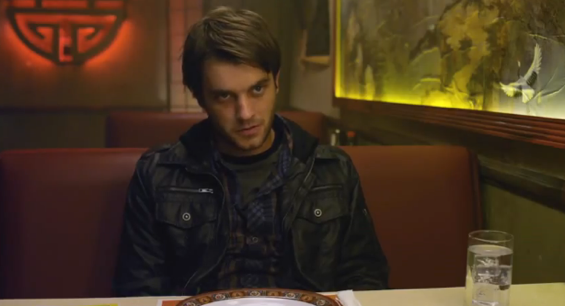
John Dies at the End (Movie Review)
Since 2004’s Shaun of the Dead the horror-comedy appears to have been going through a bit of a resurgence. Between 2006 and 2010 there were a little more than 40 horror comedies of varying financial pedigrees released. Last year we saw approximately 7 major horror-comedy releases. Cabin in the Woods is even seeing a decent amount of award buzz and critical acclaim; extremely rare for a film so steeped in genre material. This year is none less the richer with Warm Bodies releasing in February and the much-anticipated Don Conscarelli flick John Dies at the End beginning its theatrical run at the end of the month. Characteristic in most of these films is there emphasis on generic convention play and meta-narratives with a touch of ironic wit and social satire. This is not to say such self-effacing, reflexive humor has been absent in the past but the frequency with which these films are being released is indicative of a growing horror audience more literate in conventions. And while John Dies at the End trades in these qualities to varying degrees it also makes attempts at creating a satisfying mythology all its own.
Dave (Chase Williamson) is a twenty-something slacker who doesn’t hold a job and seems to spend most of his time watching infomercials, sleeping on his couch, or hanging with best friend John (Rob Mayes)…who we are told will die at the end of the movie. John, being the loveable scamp he is, likes partying, girls, and drugs. But John’s wonton hedonism catches up with him in a fierce way when after dosing a new drug called “Soy Sauce” he begins to see ghosts, demons, and other dimensions. Not to mention he can move outside space and time. After Dave accidentally exposes himself to the drug, he begins to share John’s visions, unveiling a heinous plot hatched by some type of monster-computer in another universe…and maybe some aliens (I’m honestly not quite sure). Oh yea, Paul Giamatti’s here as reporter Arnie, Doug Jones plays an inter-dimensional slug-keeper, and Clancy Brown has a turn as an Eastern European pop exorcist.
John Dies at the End has been a bit of a geeky cult albatross for nigh on three years. Originally the property was an increasingly popular 2001 comic-horror internet publication turned book by David Wong about the paranormal exploits of the aforementioned friends. Don Conscarelli, having become a fan of the material, had attached himself to a film adaptation in 2007. Seeing as how this would be Conscarelli’s first feature foray since 2002’s Bubba Ho-Tep anticipation for the loyalists out there was peaked. Also doesn’t hurt when your cast is rounded out with a peppering of “that guys”. Filming quietly began in 2010 while nuggets of publicity would occasionally filter through the ether. The film eventually had it’s premiere at the 2012 Sundance Film Festival and now is making its way to theaters for a January release this year.
So does Conscarelli’s return to features a decade later live up to expectations? Perhaps unsurprisingly it’s a yes-and-no answer. John Dies at the End certainly has a style about it that is a shade more polished than Bubba Ho-Tep. The film moves at a brisk pace, balancing its more wild set pieces nicely with enough jokes that work. Conscarelli and Wong have an adept sense of how to coax humor from their character reactions. Fans of Conscarelli’s oeuvre will probably notice a few of the director’s trademark gags. (Seriously though, nothing comes close to the campy hysteria of an actor convincingly fighting something that they are clearly holding on themselves). And at a point in geekdom when the threat of a Ghostbusters 3 has been looming for several years it is refreshing to see a narrative that borrows from the concept while adding enough of its own personality, making the Ghostbusters seem like Navy Seals by comparison.
But despite all this manic, whack job, irreverent energy the film lacks a consistent narrative thread that we are capable of holding on to. When an actual threat or clear obstacle is introduced to John and Dave it comes in the form of information dump Soy trips. The way we are placed inside and outside Soy trips becomes tiresome as they often allude to events that bear no real weight on the overarching narrative. While the flashy renderings of trips through space-time make for some kinetic imagery they also tend to negate the necessity of explaining a majority of Dave’s motivations. This is particularly evident in the frame narrative in which Dave is attempting to break the story of the “Sauce” to reporter Arnie. Why is Dave talking to Arnie? We are given one throwaway line in which Dave states he just wants his story out. Fine. But the inconsistency with which the frame story is utilized and the end it meets seems awkwardly fruitless. And while I don’t believe every horror film needs to make itself an allegory some sort of greater metaphor is noticeable absent from the film.
There’s a brief prologue that acts as a distillation of the highs and lows of John Dies at the End . We watch as Dave decapitates a neo-nazi zombie and space slug with a small axe, having to repair both the blade and hilt following each respective skirmish. Neo-Nazi Zombie returns from the grave once more stating, “That’s the axe that slayed me!”. We then hear Dave’s voice over asking “Is he right?”. The sequence seems meant to insert some sort of rumination on quintessence, a theme that certainly manifests in the film but to little effect. When considering this sequence and much of the film I was reminded of a number of other contemporary films. In particular the influence of Edgar Wright & Company (also Reuben Fleischer’s Zombieland) seems to inform much of Coscarelli’s aesthetic choices here. Granted the man made Bubba Ho-Tep. (And the Phantasm series, etc). However, the film has a show-reel identity. It knows the moments, the camera moves, and editing tricks but it starts to ring hollow, having little in the way of conflict or development to keep us intrigued. Despite all this, what John Dies at the End may lack in the way of careful plotting and interesting characters it manages to excel with a respectable amount of crudely effective jokes, slapstick, and some originality.

